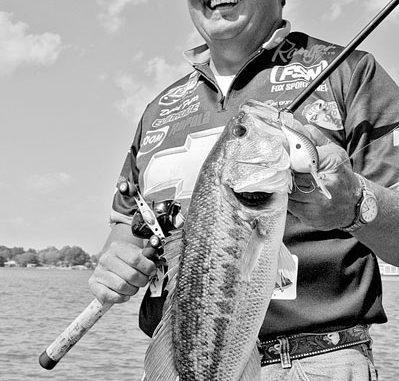
I probably like to fish for bass in June about as much as I do at any time of the year. I do fish to my strength, and it’s a great month to fish a crankbait, but I really think that June is, overall, the best month to fish for bass in North Carolina.
The reason: you can catch ’em just about anywhere you go, anyway you want to.
April is probably the big spawning month on most lakes around North Carolina, especially this year, with a full moon the last week of the month. You give those bass about three weeks to recover, and they’ll all be moving out, getting aggressive. You can catch ’em fishing topwater, flipping boat docks or cranking long points and dropoffs — June’s a good month for anybody who likes to fish.
Depending on where you’re fishing, you might find that things are a little bit different in your neck of the woods. You’ll have more fish out in deep water earlier at Lake Wylie; at Buggs Island or Gaston, you’ll have a few more fish still spawning or in the postspawn. The lakes across the middle of the state — from High Rock to Jordan and Harris — will pretty much fish the same.
Here are two things I look at. Around the first of June, most of our lakes have a pretty good shad spawn. The shad all get up on the banks, and the bass are going to follow them, so you’ll have a pretty good topwater bite. In some of our lakes in the northern and eastern parts of the state, the topwater bite could last all day. In lakes farther south, like Wylie, it will be mostly an early-morning bite. I’ll look for big, flat points; the shad like to spawn there. I’ll fish a Rapala Skitterwalk, a big, walking bait. You make a long cast close to the bank and just walk the bait out. I like to fish it in shad, white or clear colors.
The thing I really look for, however, is fish pulling out after they recover from the spawn, getting on little drops and corners, ganging up and really feeding heavily. As June progresses, they’ll move deeper and deeper. You might start off catching them five to eight feet deep, and by the end of the month, you might be out in 12 to 14 or 16 to 18 feet of water.
The mid-lake area is usually a good place to start; I think most of the fish will be from half-way back in the creeks to the main-lake. In June, with fish biting almost everywhere, you’re looking for places that are holding better-quality fish, and that means covering a lot of water to find them. But what I like to do is start at mid-lake and work my way down a little. If I’m catching quality fish, I’ll keep going. If I’m not, I’ll turn around and go up the lake. They can be anywhere, and you’ve got to fish a lot of places to find ’em. On High Rock, I might be catching them 15 feet deep on a drop on the main-lake in one place, but I might move into Swearing Creek and find them on rock veins and catch ’em on docks.
I also think that fish are moving not only deeper as the month progresses, but they’re also moving out toward the main lake. You can still catch some nice fish all the way in the backs of creeks, but June is a great month to look for quality fish on the main body of the lake.
One great thing about fishing in June is that bass tend to get schooled up. You get on the right stretch of docks or the right little point, and you’ll have a lot of fish gathered up there. If you catch one, don’t move; stay in that area and really fish it hard. I know years ago, if you caught a fish on one little point or drop, you could stay there and maybe catch 20. Nowadays, because of the fishing pressure, they’ve gotten a little smarter, and you might catch seven or eight fish on a little spot or a stretch. But understand, June is one of the better months to catch a lot of quality fish without having to move very far.
I’m doing most of my damage with a crankbait. I’ll start out with a Rapala DT-6, and by the end of the month, I’m fishing a DT-10, DT-14 or a DT-16. I like brown/bone, blues and shad colors. When I fish the smaller baits, I use a 7-foot AmericanRodsmith cranking rod. When I get out and have to fish deeper and make longer casts, I’ll go to the 7-foot-6 and 7-foot-11 models.
I know I’ve probably won more money in tournaments in other months, but June is really one of my favorites, and it should be one of yours, too. I can’t think of a month when all the bass will be biting like they are in June.
David Fritts is a 53-year-old pro bass fisherman from Lexington. He won the 1993 Bassmasters Classic champion and the 1997 FLW Tour Championship, and he was the 1994 BASS Angler of the Year. He is sponsored by Tums, Ranger boats, Evinrude outboards, Rapala, VMC hooks, Zoom, American RodSmiths and Bass Pro Shops.




Be the first to comment